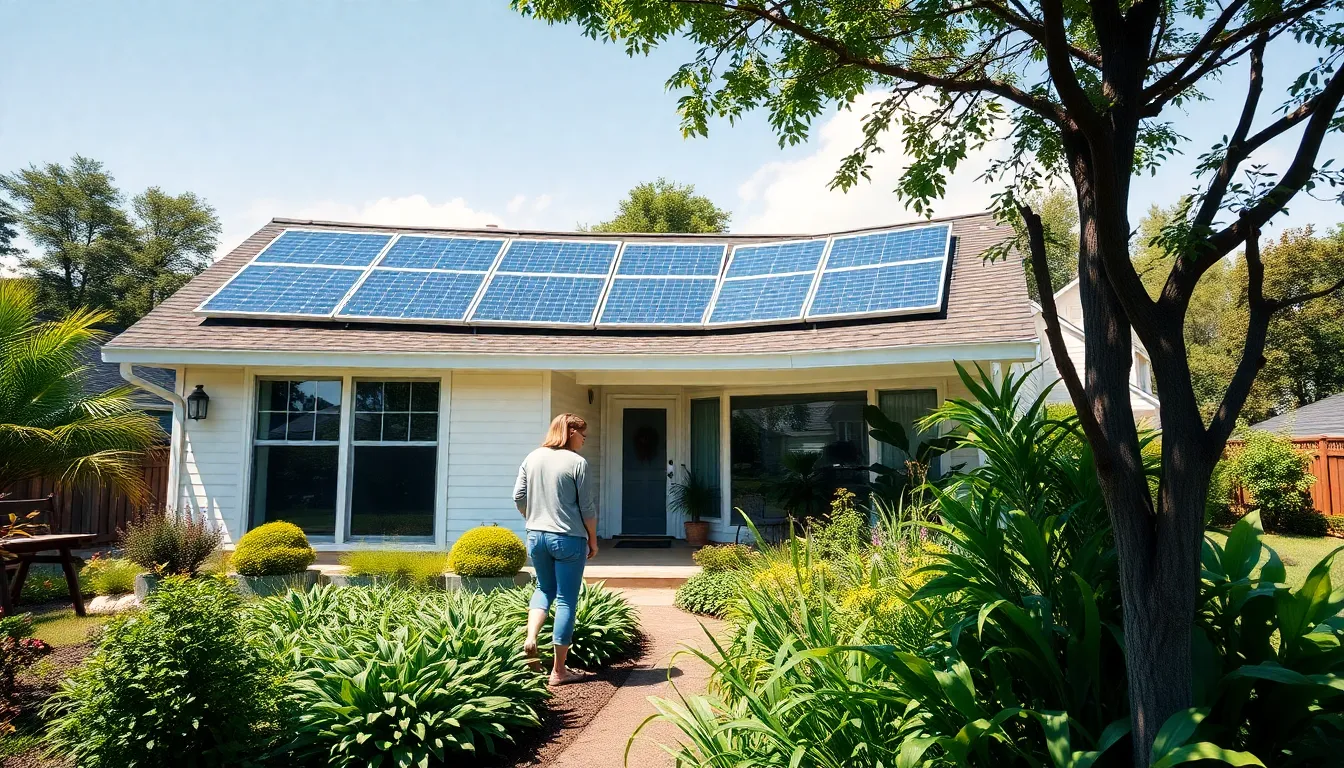Table of Contents
ToggleTransforming a home into an eco-friendly haven isn’t just a trend; it’s a lifestyle choice that benefits both the planet and its inhabitants. As awareness of environmental issues grows, more homeowners are seeking ways to reduce their carbon footprint while enhancing their living spaces. A green home makeover can encompass everything from energy-efficient appliances to sustainable materials, creating a harmonious blend of style and sustainability.
In this journey towards a greener home, small changes can lead to significant impacts. Whether it’s installing solar panels or opting for recycled materials, each decision contributes to a healthier environment. This article explores innovative ideas and practical tips for anyone looking to embark on a green home makeover, proving that being environmentally conscious can also be stylish and affordable.
Overview of Green Home Makeover
Green home makeovers focus on creating sustainable living spaces that enhance environmental quality and reduce energy consumption. Homeowners increasingly seek ways to implement eco-friendly solutions that combine functionality with style.
Sustainable materials play a significant role in these transformations. Bamboo, reclaimed wood, and recycled metal serve as effective alternatives to conventional building materials. Select paints with low volatile organic compounds (VOCs) to maintain indoor air quality while still achieving aesthetic appeal.
Energy efficiency is another critical aspect. Installing Energy Star-rated appliances, optimizing insulation, and upgrading windows to double-glazed options contribute to decreased utility bills. Solar energy systems provide renewable power, minimizing reliance on fossil fuels.
Water conservation techniques also elevate the effectiveness of green makeovers. Fixtures such as low-flow showerheads, dual-flush toilets, and rainwater harvesting systems enhance water usage efficiency. Landscaping with drought-resistant plants reduces the need for irrigation.
Incorporating smart technologies further enhances sustainability. Smart thermostats, energy monitoring systems, and automated lighting adjust energy consumption based on user habits, providing convenience while promoting eco-responsibility.
Green home makeovers not only improve the environmental impact but also create healthier, more comfortable living environments. By implementing these strategies, homeowners contribute to a sustainable future while enjoying the benefits of their transformed spaces.
Benefits of Going Green

Going green offers numerous advantages that extend beyond aesthetics. Homeowners can experience significant benefits in both environmental impact and financial savings.
Environmental Impact
Going green directly contributes to a healthier planet. Sustainable practices reduce carbon emissions, lower energy consumption, and minimize waste. For instance, using renewable energy sources, such as solar or wind, cuts reliance on fossil fuels, decreasing pollution levels. Additionally, sustainable materials like bamboo and recycled steel lessen the demand for virgin resources, which curtails habitat destruction. Implementing water-saving devices, such as low-flow faucets and rainwater harvesting systems, conserves vital water resources. These collective efforts lead to improved air quality, biodiversity, and a more balanced ecosystem.
Financial Savings
Financial savings often accompany eco-friendly renovations. Energy-efficient upgrades, including Energy Star-rated appliances and enhanced insulation, can significantly reduce monthly utility bills. Homeowners typically see a return on investment within a few years due to decreased energy costs. Additionally, government incentives and tax credits for green upgrades can offset initial costs. Adopting water-efficient fixtures also lowers water bills, providing additional savings over time. In the long run, sustainable homes often maintain higher resale values, attracting buyers interested in energy efficiency and eco-friendliness.
Key Components of a Green Home
Creating a green home involves various essential components. These elements not only enhance the living environment but also contribute significantly to sustainability.
Energy Efficiency
Energy efficiency plays a crucial role in a green home. Installing Energy Star-rated appliances reduces energy consumption, leading to lower utility bills. Optimizing insulation in walls and attics minimizes heat loss, maintaining comfortable indoor temperatures. Upgrading to double-glazed windows prevents drafts and enhances thermal performance. Programmable thermostats allow homeowners to control heating and cooling based on their schedules, further conserving energy. Incorporating renewable energy sources like solar panels significantly decreases reliance on fossil fuels and can generate savings in the long run.
Sustainable Materials
Sustainable materials are foundational to eco-friendly home design. Utilizing bamboo, reclaimed wood, and recycled metal offers durable, stylish alternatives to conventional building materials. These materials reduce the environmental impact of home construction and renovation. For example, bamboo grows rapidly and absorbs more carbon dioxide during its life cycle compared to traditional hardwoods. Reclaimed wood not only adds character but also prevents deforestation. Eco-friendly insulation options, such as cellulose made from recycled paper, improve energy efficiency while minimizing energy use during production.
Water Conservation
Water conservation techniques are vital in a green home. Installing low-flow fixtures in showers and faucets reduces water flow without sacrificing performance. Rainwater harvesting systems capture and store rain for irrigation and non-potable uses, decreasing reliance on municipal water supply. Xeriscaping, which features drought-resistant plants, minimizes water consumption while enhancing curb appeal. Additionally, smart irrigation systems optimize water use by delivering precise amounts based on weather conditions, ensuring efficient landscape watering. Implementing these strategies fosters a more sustainable relationship with water resources.
Tips for a Successful Green Home Makeover
Successfully transforming a home into an eco-friendly space involves careful planning and thoughtful product choices. These tips guide homeowners toward sustainable decisions that enhance both functionality and environmental responsibility.
Planning Your Project
Planning a green home makeover requires assessing current needs and setting clear goals. Homeowners should evaluate existing structures for energy efficiency, identifying areas for improvement. Developing a budget allows for prioritizing investments in energy-efficient appliances and renewable energy systems like solar panels. Creating a timeline helps manage the project effectively. Successful projects include support from professionals experienced in sustainable design, ensuring that each step aligns with eco-friendly practices.
Choosing Eco-Friendly Products
Selecting eco-friendly products forms the cornerstone of a sustainable home. Homeowners should prioritize materials with low environmental impact, such as bamboo, reclaimed wood, or recycled metal. Choosing Energy Star-rated appliances promotes efficiency and reduces energy consumption. Selecting low-VOC paints and finishes minimizes indoor air pollutants. Fixtures that conserve water, like low-flow faucets and toilets, significantly decrease water usage. Investing in durable products ensures longevity, reducing waste over time. By choosing wisely, homeowners contribute to a healthier living environment while enhancing their green lifestyle.
Challenges to Consider
Homeowners face several challenges during a green home makeover. Understanding these barriers helps in making informed decisions throughout the process.
Budget Constraints
Budget constraints often impact the extent of eco-friendly renovations. Sustainable upgrades may have higher upfront costs, which can deter homeowners from pursuing green options. Factors like sourcing renewable energy systems, purchasing energy-efficient appliances, and using sustainable materials contribute to initial expenses. Setting a realistic budget that accounts for these costs, while also exploring financing options and potential government incentives, ensures homeowners can effectively manage their investments while achieving sustainable goals.
Sourcing Materials
Sourcing materials presents another challenge in sustainable renovations. Not all building supplies are created equal; finding affordable and environmentally friendly options may require extra effort. Homeowners face limitations in availability, as certain sustainable materials, such as reclaimed wood or bamboo, depend on regional suppliers. Prioritizing local sources not only minimizes transportation emissions but also supports the community. Researching certifications like Forest Stewardship Council (FSC) or Global Organic Textile Standard (GOTS) can help homeowners select truly sustainable products, while utilizing online marketplaces and networks can provide access to a wider range of eco-friendly materials.
Transforming a home into an eco-friendly haven is more than just a trend; it’s a commitment to a sustainable future. By embracing green practices, homeowners not only enhance their living spaces but also contribute to the well-being of the planet. Each thoughtful choice—from energy-efficient appliances to sustainable materials—plays a crucial role in reducing carbon footprints and conserving resources.
The journey toward a greener home can be both rewarding and stylish. With careful planning and a focus on sustainable solutions, anyone can create a comfortable and environmentally friendly space. As awareness of environmental issues continues to grow, making these changes becomes an essential step toward a healthier lifestyle and a better world for future generations.




